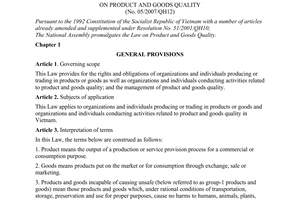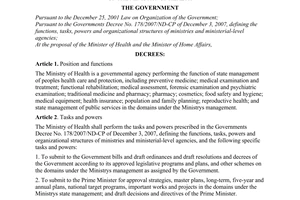Nội dung toàn văn Circular No. 14/2011/TT-BYT general guidance on food sampling to serve
|
THE
MINISTRY OF HEALTH |
THE
SOCIALIST REPUBLIC OF VIETNAM |
|
No.: 14/2011/TT-BYT |
Ha Noi, April 01, 2011 |
CIRCULAR
GENERAL GUIDANCE ON FOOD SAMPLING TO SERVE THE INSPECTION AND EXAMINATION OF FOOD SAFETY, HYGIENE AND QUALITY
Pursuant to the Law on product and goods quality dated November 21, 2007;
Pursuant to the Decree No.132/2008/ND-CP dated December 31, 2008 of the Government stipulating in detail the implementation of a number of articles of the Law on product and goods quality;
Pursuant to the Decree No.188/2007/ND-CP dated December 27, 2007 of the Government stipulating the functions, duties, powers and organizational structure of the Ministry of Health;
The Ministry of Health makes guidance on sampling to serve the inspection and examination of food safety, hygiene and quality as follows:
Article 1. Scope of adjustment and subjects for application.
1. This Circular makes guidance for the general principles on food sampling to serve the inspection and examination of food safety, hygiene and quality.
2. This Circular is applicable to organizations and individuals related to the activity of food sampling during the inspection and examination of food safety, hygiene and quality.
Article 2. Explanation of terms
In this Circular, the following terms are construed as follows:
1. Food sampling is a technical manipulation in order to obtain a certain food volume that is representative and homogeneous to serve the analysis, assessment of food safety, hygiene and quality
2. Batch of food products is a defined quantity of a type of product of the same name, quality, materials, and shelf life and be produced in the same facility.
3. Sample for testing is a general sample used for testing and assessment of criteria in the laboratory.
4. Retained sample is the one having the same characteristics with the tested sample and retained at the testing facility, the sampling facility or the facility chosen by the head of examination and inspection group;
Article 3. Requirements for the person sampling
1. Being the member of the examination and inspection group;
2. Being trained and having certificate of food sampling technique.
3. Having to take sample directly at the facility or as chosen by the inspection group;
4. Having to make minutes of the sampling, minutes of sample delivery and sealing in the form as prescribed in Annex III, IV and V promulgated together with this Circular.
Article 4. Responsibilities of the sampler
1. Having to prepare all procedures, tools and equipment for sample taking and sample preservation.
2. Properly complying with the technical process to ensure the objectivity, honesty in the process of sampling, sample transportation and delivery for the testing unit.
Article 5. Process of sampling
1. The process of sampling must be supervised and fully recorded. All heterogeneous signs and fault of the product and preservation packaging must be recorded.
2. After completing the process of sampling, the sample must be delivered to the testing unit in a shortest time.
Article 6. Sampling cost
The sampling cost is implemented as prescribed in Article 41 and 58 of the Law on product and goods quality 2007 and other regulations of the law.
Article 7. The volume of sample be taken and sampling method
1. For each product, the minimum and maximum sample volume are taken as prescribed in Annex I promulgated together with this Circular.
2. The sampling method for groups of product prescribed in Annex II promulgated together with this Circular.
Article 8. Preservation conditions and time of sample storage
1. The preservation conditions during the process of taking, transportation, delivery and storage of sample must be consistent with the storage requirements announced by the manufacturer.
2. Based on the actual situation, the head of the examination and inspection group will decide on time of sample storage for the retained sample and tested sample.
Article 9. Effect
This Circular takes effect on June 01, 2011
Article 10. Responsibility for implementation organization
Department of Food Hygiene and Safety is responsible for presiding over and coordinating with the concerned agencies to organize and deploy the implementation of this Circular.
Any problem arising in the course of implementation should be promptly reported to the Ministry of Health (Department of Food Hygiene and Safety) for consideration and settlement.
|
|
PP.
MINISTER |
ANNEX I
SAMPLE
VOLUME TAKEN FOR TESTING
(Promulgated together with the Circular No. 14/2011/TT-BYT dated June 01,
2011, of the Minister of Health)
|
No. |
Product |
Minimum sample volume |
Maximum sample volume |
|
1 |
Milk and dairy products |
100 g (ml) |
1.5 kg (liter) |
|
2 |
Beverage |
500 ml (g) |
6 liter (kg) |
|
3 |
Cigarettes |
03 (packet) |
05 (packet) |
|
4 |
Tea |
100 g |
1 kg |
|
5 |
Seasoning |
100 g |
1 kg |
|
6 |
Animal oil and fat |
100 g (ml) |
1.5 kg (liter) |
|
7 |
Ice cream and food ice |
150 g |
2.5 kg |
|
8 |
Vegetables and vegetable products |
150 g |
2.5 kg |
|
9 |
Cocoa and chocolate products |
150 g |
1 kg |
|
10 |
Candy |
100 g |
1 kg |
|
11 |
Cake |
100 g |
1 kg |
|
12 |
Cereal and beans |
100 g |
1.5 kg |
|
13 |
Meat and meaty product |
150 g |
1.0 kg |
|
14 |
Aquatic products |
150 g |
1.5 kg |
|
15 |
Eggs and egg products |
150 g |
1.5 kg |
|
16 |
Sugar |
100 g |
1.5 kg |
|
17 |
Honey and honey products |
100 g (ml) |
1.5 kg (liter) |
|
18 |
Food for infants and young children |
150 g (ml) |
1.5 kg (liter) |
|
19 |
Coffee and coffee products |
150 g (ml) |
1.5 kg (liter) |
|
20 |
Oilseeds and oilseed products |
100 g |
1.5 kg |
|
21 |
Functional food |
100 g |
1.5 kg |
Note:
1. The minimum sample volume is the one sufficient for testing a target of product. Depending on the purpose of examination and inspection process, the sample volume taken can be increased or decreased and the type of product not existing in the above section can be taken as decided by the head of examination and inspection group in conformity with requirement of examination and inspection.
2. In case there is not sufficient sample for storage, any changes must be clearly stated in the minutes of the sampling and minutes of sampling delivery.
ANNEX II
SAMPLING
METHOD
(Promulgated together with the Circular No. 14/2011/TT-BYT dated June 01,
2011 of the Minister of Health)
|
No. |
Product object |
Number of standards / regulation / number of guiding documents |
|
1 |
Guidance for setting up the sampling program |
TCVN 6663-1: 2002 |
|
2 |
Guidance for sampling in the river and stream |
TCVN 6663-6: 2008 |
|
3 |
Guidance for sampling of drinking water and water used for food and beverage processing |
TCVN 5995: 1995 |
|
4 |
Guidance for sampling of underground water |
TCVN 6000: 1995 |
|
5 |
Guidance for sampling in natural and artificial lake and pond |
TCVN 5994: 1995 |
|
6 |
Guidance for sampling of rainwater |
TCVN 5997: 1995 |
|
7 |
Beer – Rule of acceptance and sampling method |
TCVN 5591: 1991 |
|
8 |
Food products and seasoning. The order of sampling for microbiological analysis |
TCVN 4886: 1989 |
|
9 |
Seasoning. Sample taking |
TCVN 4889: 1989 ISO 948: 1988 |
|
10 |
Milk and dairy products. Guidance for sample taking. |
TCVN 6400: 2010 ISO 707: 2008 |
|
11 |
Milk and dairy products. Sample taking. Testing by exclusion sign. |
TCVN 6266: 2007
|
|
12 |
Milk and dairy products. Sample taking. Testing by quantitative sign. |
TCVN 6267: 1997 ISO 8197: 1988 |
|
13 |
Meat and meaty products. Sample taking and preparation. Part 1: Sample taking |
TCVN 4833-1: 2002 |
|
14 |
Aquatic products. Sample taking and sample preparation |
TCVN 5276: 1990 |
|
15 |
Tea. Sample taking |
TCVN 5609: 2007 ISO 1839: 1980 |
|
16 |
Green coffee oblique sampling |
TCVN 4809: 1989 |
|
17 |
Green coffee. Sample taking |
TCVN 5702: 1993 |
|
18 |
Packaged green coffee. Sample taking |
TCVN 6539: 1999 ISO 4072: 1998 |
|
19 |
Instant coffee – Sampling method for package with liners |
TCVN 6605: 2007 ISO 6670: 2002 |
|
20 |
Cocoa beans |
TCVN 7521: 2005 ISO 2292: 1973 |
|
21 |
Canned food |
TCVN 4409: 1987 |
|
22 |
Candy |
TCVN 4067: 1985 |
|
23 |
Sugar. Sample taking |
TCVN 4837: 2009 |
|
24 |
Cereal and beans and grinding products - Sample taking from the block of goods |
TCVN 5451: 2008 ISO 13690: 1999 |
|
25 |
Fresh vegetables. Sample taking |
TCVN 5102: 1990 ISO 874:1980 |
|
26 |
Animal and vegetable oil. Sample taking |
TCVN 2625: 2007 ISO 5555: 2001 |
|
27 |
The recommended sampling method for determining the residue of insecticide consistent with the maximum residue limit (MRL) |
TCVN 5139: 2008 |
Note: Based on the actual situation, the head of examination and inspection group can decide on using other equivalent sampling method.
------------------------------------------------------------------------------------------------------
This translation is made by LawSoft,
for reference only. LawSoft
is protected by copyright under clause 2, article 14 of the Law on Intellectual Property. LawSoft
always welcome your comments



